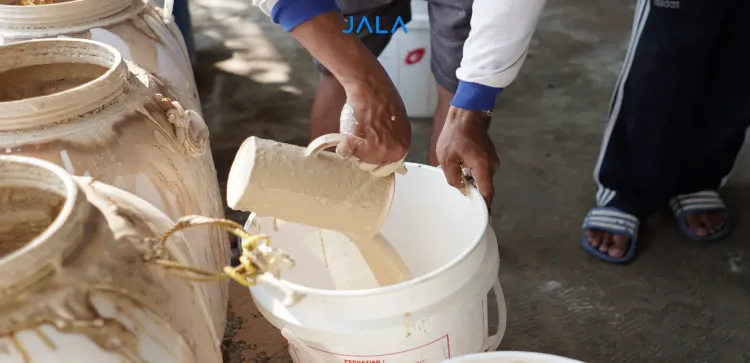
December marks the rainy season in various regions of Indonesia. As shrimp cultivation is conducted outdoors, rainfall serves as an external factor that influences the water quality conditions of shrimp cultivation. According to the Bulan Desember menandakan terjadinya musim hujan di berbagai daerah di Indonesia. Indonesian Meteorology, Climatology, and Geophysics Agency (BMKG), from December 2023 to February 2024, a significant portion of Indonesia is predicted to experience medium to high rainfall.
In December 2023, 59.40% of regions, including Sulawesi and Sumatra, are expected to have moderate rainfall (100 – 300 mm/month), while 39.94%, including Java and Kalimantan, are predicted to experience high to very high rainfall (>300 mm/month). Although shrimp farmers need to take various precautionary measures during the rainy season, rainwater also brings several benefits to shrimp ponds. Before delving into the benefits, let's get to know the composition of rainwater below.
Composition of rainwater
Rainwater is an electrolyte containing various ions, and its chemical composition varies from one place to another. The primary ions commonly found in rainwater include sodium, potassium, magnesium, calcium, chloride, bicarbonate, and sulfate ions, along with ammonia, nitrate, nitrite, nitrogen, and other nitrogen compounds. Additionally, there are trace amounts of iodine, bromine, and iron.
Benefits of rainwater for shrimp farms
1. Decrease pond pH
Rainwater is slightly acidic (pH 5.6-6), and thus can help with the reduction of pH in shrimp ponds, primarily due to its carbonate, sulfate, and nitrate ion content. Therefore, rainwater can naturally assist shrimp farmers in addressing excessively high pond pH levels. Elevated pH fluctuations typically occur due to high feed input, high phytoplankton density, or as a result of phytoplankton photosynthesis activity, which absorbs CO₂ from the water and releases oxygen. Excessively high pH, especially above 10, can increase the toxicity of toxic compounds such as BGA, free ammonia, and bacteria, and should therefore be mitigated to prevent shrimp mortality.
2. Binds with aluminum from the pond bottom
Aluminum poses a significant threat to shrimp as it can hinder respiratory processes, osmotic regulation, and shrimp metabolism, ultimately leading to mortality. The acidic content in rainwater can bind with aluminum at the pond's bottom, causing aluminum to rise to the surface and can be discarded.
3. Reduces salinity
Salinity tends to increase during the dry season. When salinity is excessively high, shrimp growth slows, and Feed Conversion Ratio (FCR) increases. Shrimp also become more susceptible to diseases. With the onset of the rainy season, pond water mixes with rainwater which has low salt content, reducing salinity.
4. Decreases temperature
Just like salinity, temperature during the dry season can become excessively high for shrimp. The rainy season helps lower temperatures, promoting controlled shrimp metabolism and preventing an increase in FCR.
What farmers should remember when cultivating during rainy season
While rainwater brings several benefits to shrimp ponds, it can also adversely impact water quality, requiring continuous attention to prevent negative effects on shrimp. The rainy season leads to a decrease in microalgae populations due to pH reduction, a decline in mineral and microelement concentrations, increased turbidity, and reduced sunlight intensity. Consequently, the population of heterotrophic bacteria increases due to the higher availability of nutrients from deposited dead algae cells and organic material from the pond bottom. Without proper handling, this can lead to a surge in pathogenic bacteria, making shrimp more susceptible to diseases. Therefore, in regions with high rainfall, careful management and preventive measures against decreased water quality during the rainy season are essential to ensure a smooth cultivation.
What farmers should do when cultivating during rainy season
1. Dispose and replace pond water
The continuous fall of rainwater into shrimp ponds can lead to extreme changes in water quality parameters, causing stress to shrimp. Farmers can manage this by draining and replacing surface water through an upper drainage system. In the case of heavy rain, it is essential to gradually release pond water to prevent a sudden decrease in salinity and potential damage. Additionally, changing the water also helps in preventing massive microalgae mortality by reducing algae cell density.
Read more: Water Source Quality Standard for Shrimp Cultivation
2. Re-evaluate feed management
The rainy season results in cooler temperatures, causing shrimp to eat less. Thus, it is advisable not to overfeed so that uneaten shrimp will not accumulate in the pond and decline in water quality. Monitor feed requirements using feeding trays and ensure that waste materials in the pond bottom are removed through siphoning. Farmers can also introduce probiotics to promote the growth of waste-decomposing bacteria in the pond.
3. Monitor water quality regularly
Shrimp cultivation cannot be separated from water management. Regularly monitor water conditions using a suitable water quality measurement device to ensure crucial parameters like temperature, pH, dissolved oxygen (DO), and salinity remain stable. JALA is #HeretoHelp with Baruno, a multiparameter measurement device for 5 water quality parameters, namely DO, pH, salinity, temperature, and oxidation-reduction potential (ORP). Measurement data is stored in the JALA cloud, accessible anytime and anywhere via the JALA App. Moreover, farmers should activate all aerators, maintain DO levels above 4 ppm.
Read more: Giving Lime in Shrimp Pond
4. Do regular sampling
Sampling is beneficial for assessing shrimp conditions, detecting diseases, stress, or mortality. Conduct regular sampling during the rainy season, adjust pond conditions accordingly, and record data in the JALA App for comprehensive monitoring.
While rainwater brings benefits to ponds, farmers must understand its potential negative impacts and take appropriate mitigation measures. Regular monitoring is crucial to ensure productive and sustainable shrimp cultivation throughout both the rainy and dry seasons.





